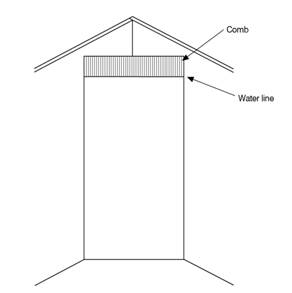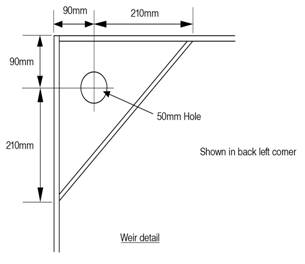|
Filtration:
Canister:
This is a self contained unit housing a number of compartments, containing filter media.
The flow of water is taken from the tank via a loop of pipe over the rear of the tank which is set as a siphon.
The water flows into the canister which has a small pump in the head. The water is returned by a further pipe normally
returning to the opposite end of the tank. We would always recommend using two canister filters instead of one large one
thus giving you a safety margin should one fail.
Sumps and Weirs:
A weir is a water tight partition containing one or two holes. The top of the partition contains a comb which just sits below
the working water level of the tank. There is no limit to the number of Weirs you can have in your setup. Basically the water
from your tank flows over the top of the Weir and enters one of the pipes which takes the water into your sump.
The action of the water passing over the Weir and entering the pipe work can become noisy, just like a bath when it empties
and draws air into the pipe. You can do a number of things to avoid this happening. First design your pipe work from your tank
to your sump with as little restriction as possible. In other words use larger pipe that is required for the quantity of water flowing
into the Weir. Try to avoid sharp 90 degree bends in the pipe if you do need to use bends use long sweeping bends.
As a last resort you can install a Durso pipe which is a length a pipe which fits into the fitting at the bottom of the Weir runs up the
rear of the Weir and turns back on its self, thus always having the outlet underwater. The second hole which is optional is used for
the return pipe from the sump and is piped up the rear of the Weir and taken to a point in the tank were you want the return. We always
recommend that if you only have one Weir that you keep a spare return pump just as a backup.

 |
 |
 |
 |
You can also have square end, square corner, coast to coast and external Weirs.
Your sump is a small tank which should be 2/3rds the size of your main tank. This will normally be contained in your cabinet
or anywhere that’s below your main tank. Your sump should be split-up into sections to allow for the installation of media
for the filtration of your tank water.
I am sure you will find so much conflicting information with regards to sump design and what type of media should be used.
Whatever the design there are a few important facts you should be aware of. When your system is running your tank water will
normally sit about 20mm up on the comb of your Weir. Should your pump fail this 20mm of water will continue to flow over your
Weir into your sump. To prevent flooding any design should take this factor into account. Your running water level in your sump
is set by the height of the over partitions. You first need to calculate the volume of water that will pass over the top of the Weir.
To do this you need to multiply the length of the tank by the width of the tank by 20 all in mm. We are happy to help with this, please ask.
The second is if you use mud in your sump you will also have lighting above it. Beneficial bacteria that will colonise your sump prefer reduce light.
So the section of your sump containing the mud should be constructed with solid black glass. This will then prevent any overspill of light thus reducing
or limiting the functioning of your sump.
Piping:
If you are planning a reef tank, we recommend that you use PVC-U piping and not basic domestic PVC plumbing.
Salt water is abrasive just think what it does to the rocks on our coast line. The last thing you want is the erosion of the pipe leeching toxins from the plastic into your tank water.
To prevent any leaking our tank connectors should be fitted as per the drawing below.
Click on the link for full data on our plumbing range Plumbing Data PDF
MATURATION:
Once you are up and running you can then start the maturation process. Please start the cycle by adding maturation fluid, media from an existing working
system or commercially available bacterial. Please DO NOT use living fish to complete this process.
The process can take up to 28 days to complete. You have come this far, please be patience. Once the Nitrite level is zero the process is complete and you
can start adding inhabitants to your tank. Do this slowly as the beneficial bacteria in your filter need to increase as the occupants increase.
© Aquarium Plumbing Ltd.
The information provided in our calculations, charts, drawings and pictures was compiled to assist you in setting up your aquarium. We are not responsible
for any problems that may arise from following this information.
|

